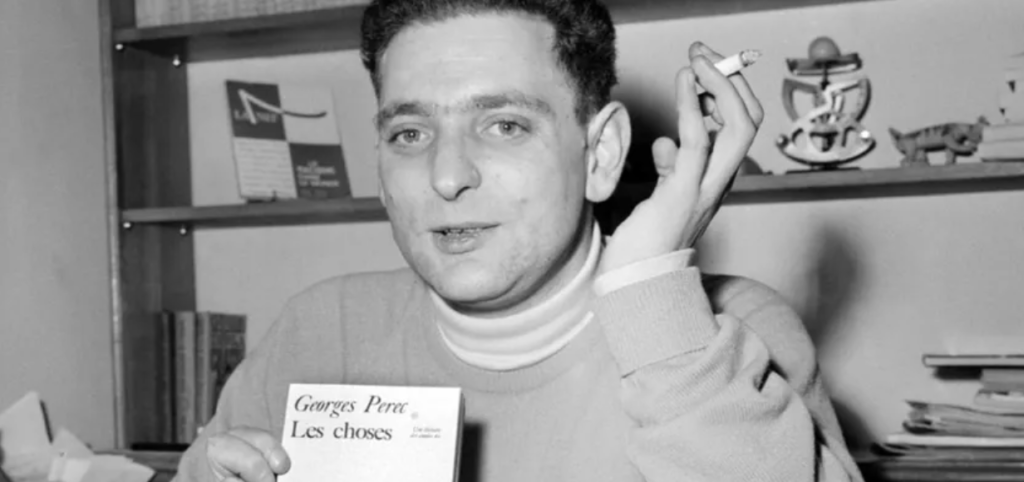David Ewing is a doctoral candidate in Modern French at the University of Cambridge. His research considers the relationship between everyday life and narrative fiction in postwar France.
A history of the everyday in modern European literature might begin with Baudelaire, who refused the Romantic flight from daily reality to the realm of the marvellous: by bringing thought to bear on poetry, the everyday could be made to eat away at itself, eventually yielding a marvellous truth that would cancel and replace it. Generations later, the Surrealists would find only new means to the same end: the dissolution of the ordinary into the extraordinary. Meanwhile, Flaubert, Baudelaire’s partner in prose, was to develop a style that could linger on the everyday, but less to celebrate its richness than to underscore its banality. More hospitable was Joyce’s Ulysses (1922), a work whose poly-ness (-phony, -rhythm, -valence, etc.) was able to transfigure – but not yet banish – the everyday. The view from the mid-twentieth century, however, was that literature had been unable to come good on the possibilities opened by Joyce. If Claude Simon’s La Route des Flandres (The Flanders Road, 1960) bears notable similarities to Joyce’s masterpiece, it does not so much metamorphose the time, speech, and life of the everyday, as cool those aspects to a point of stasis; and if this process generates possibilities of its own, these have less to do with everyday reality than with literature as a project unto itself.
This is a caricature of the history of literature that underpins Henri Lefebvre’s formidable body of writings on everyday life. An abridged version of the story appeared in the first volume of his Critique de la vie quotidienne (Critique of Everyday Life, 1947); additional scenes are to be found in his primer of 1967, La Vie quotidienne dans le monde moderne (Everyday Life in the Modern World). In the latter work, Lefebvre asked what had changed between Ulysses and La Route des Flandres: the capacity of literature to transform everyday life through representational means, or everyday life as such? The answer, in short, was both, with the upshot that only critique could hope to grasp, and transform, the totality of the everyday. At least one facet of this argument – namely, that narrative fiction after modernism struggled to find a productive relationship with everyday life – has proven durable: in Modernism and the Ordinary (2009), Liesl Olson suggests that ‘theorists like Lefebvre begin to write about the everyday when it becomes a question of whether the novel or postmodern writing more generally can represent the everyday through the conventions of realism.’[1] But in what texts is such a crisis of representation most acutely posed, and what is offered as a way out? If it is not straightforwardly a flight from the everyday, what can the path of travel tell us about the potential of narrative fiction vis-à-vis everyday life?

My research homes in on the relationship between ordinary experience and French narrative fiction in the period bookended by the publication of Lefebvre’s first volume of the Critique in 1947 and the appearance of its final instalment in 1981. In the thirty or so years following the Second World War, writers such as Marguerite Duras, Nathalie Sarraute, Michel Butor, and Georges Perec, whose names are often found in parentheses accompanying an invocation of le nouveau roman (and, with it, rather un-ordinary connotations of abstraction, formalism, and elitism), were seeking to restage the encounter between the novelistic form and experience. To be sure, the category of experience is capacious; only with some force can it be reduced to the everyday. But in taking a corpus of texts written in the wake of literary modernism and plotting the movements staged between ordinary experience and its counterpoints (extraordinary experience, the event, death, life grasped in the singular, and so on), it is possible to generate a set of ideal types that represent the possibilities opened by experimental fiction for dealing with – and, ultimately, vesting value in – the everyday. This way of reading for the everyday not only allows us to ask how successfully such texts worked on the everyday lives of their original readers; it also allows us to rethink, or reperceive, the phenomenological aspects of the everyday through some of the most daring apprehensions of experience, space, and time in the history of the novel.
David Ewing, doctoral candidate at the University of Cambridge
[1] Liesl Olson, Modernism and the Ordinary (Oxford ; New York: Oxford University Press, 2009), p. 14.
